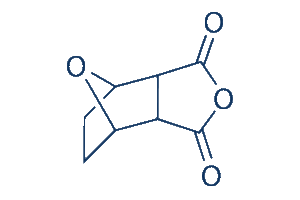This product is for research use only, not for human use. We do not sell to patients.

| Size | Price | Stock |
|---|---|---|
| 500mg | $50 | 3-6 Days |
| 1g | $80 | 3-6 Days |
| 5g | $150 | 3-6 Days |
| 10g | $250 | 3-6 Days |
| 25g | $450 | 3-6 Days |
Cat #: V3133 CAS #: 5442-12-6 Purity ≥ 98%
Description: Norcantharidin (also known as NCTD; Endothall anhydride, Norcantharadine) is a dual inhibitor of c-Met and EGFR with anticancer activity. It can induce cell cycle arrest at G2/M phase in HCT116 and HT29 cells. NCTD inhibits not only the expression of the total EGFR and the p-EGFR (phosphorylated EGFR) but also the expression of the total c-Met and the pc-Met (phosphorylated c-Met) in colon cancer cells. Norcantharidin is also an inhibitor of protein phosphatase types 1, 2A and 2B, and can arrest the cell cycle at G2/M phase in K562 human myeloid leukemia cells, and inhibit DNA synthesis in HL-60 cells. Norcantharidin is a demethylated derivative of cantharidin, which is an anticancer active ingredient of traditional Chinese medicine.
Publications Citing InvivoChem Products
Product Promise

- Physicochemical and Storage Information
- Protocol
- Related Biological Data
- Stock Solution Preparation
- Quality Control Documentation
| Molecular Weight (MW) | 168.15 |
|---|---|
| Molecular Formula | C8H8O4 |
| CAS No. | 5442-12-6 |
| Storage | -20℃ for 3 years in powder form |
| -80℃ for 2 years in solvent | |
| Solubility In Vitro | DMSO: 33 mg/mL (196.3 mM) |
| Water: NA | |
| Ethanol: NA | |
| Solubility In Vivo | NA |
| Synonyms | Endothall anhydride |
| Protocol | In Vitro | In vitro activity: Norcantharidin (also known as NCTD) is a dual inhibitor of c-Met and EGFR. It has anticancer activity and can induce cell cycle arrest at G2/M phase in HCT116 and HT29 cells. NCTD inhibits not only the expression of the total EGFR and the p-EGFR (phosphorylated EGFR) but also the expression of the total c-Met and the pc-Met (phosphorylated c-Met) in colon cancer cells. Cell Assay: Norcantharidin is also an inhibitor of protein phosphatase types 1, 2A and 2B, and can arrest the cell cycle at G2/M phase in K562 human myeloid leukemia cells, and inhibit DNA synthesis in HL-60 cells. HT29 and HCT116 cells suspended in complete media are seeded in 96-well plates (2000 cells/well). After growing for 24 h in incubator, media are aspirated and 0.2 mL complete media containing serial concentrations of NCTD are added to each well. After incubating the plate for 24, 48, or 72 h, 20 μL of resazurin (2 mg/mL dissolved in water) is added to each well. The fluorescent signal is monitored using 544 nm excitation and 595 nm emission wavelengths by Spectramax M5 plate reader after incubation at 37 °C for 16 h in the incubator. The number of living cells in each well is proportional to the relative fluorescence unit (RFU) measured by the assay. |
|---|---|---|
| In Vivo | Norcantharidin (NCTD) inhibits xenografted tumor growth in a dose- and time-dependent manner. Tumor volume decreases with an increased tumor inhibitory rate in the NTCD group compared with the control group. The apoptosis rate increases along with a decreased percentage of cells in S phase in the NTCD group compared with the control group. The morphological changes of apoptosis such as nuclear shrinkage, chromatin aggregation, chromosome condensation, and typical apoptosis bodies in the xenografted tumor cells induced by NCTD are observed. The expression of cyclin-D1, Bcl-2 and survivin proteins/mRNAs decrease significantly, with increased expression of p27 and Bax proteins/mRNAs in the NCTD group compared with the control group. NCTD is reported clinically as an anti-tumor drug against hepatoma, esophageal and gastric carcinoma, and leucopenia. | |
| Animal model | Tumor xenograft model of human gallbladder carcinoma in nude mice |
| Solvent volume to be added | Mass (the weight of a compound) | |||
|---|---|---|---|---|
| Mother liquor concentration | 1mg | 5mg | 10mg | 20mg |
| 1mM | 5.9471 mL | 29.7354 mL | 59.4707 mL | 118.9414 mL |
| 5mM | 1.1894 mL | 5.9471 mL | 11.8941 mL | 23.7883 mL |
| 10mM | 0.5947 mL | 2.9735 mL | 5.9471 mL | 11.8941 mL |
| 20mM | 0.2974 mL | 1.4868 mL | 2.9735 mL | 5.9471 mL |
This equation is commonly abbreviated as: C1 V1 = C2 V2
- (1) Please be sure that the solution is clear before the addition of next solvent. Dissolution methods like vortex, ultrasound or warming and heat may be used to aid dissolving.
- (2) Be sure to add the solvent(s) in order.




































